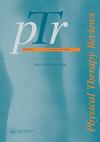强制延长体位治疗各向同性水平管BPPV的有效性:系统回顾
IF 0.8
Q4 REHABILITATION
引用次数: 0
摘要
摘要背景地向性水平管BPPV可通过横摇或侧躺两种方法有效治疗。1997年首次描述的强制延长体位(FPP)可以单独使用,也可以与这些滚转操作或侧躺操作联合使用,用于治疗各向大地水平管BPPV。目的本系统综述的目的是确定FPP治疗各向异性水平管BPPV的有效性。方法采用CINAHL Complete、ProQuest Medical Database、PubMed、Web of Science、Wiley Online Library等数据库进行文献检索。使用的搜索词是地向性和(水平或横向)和眩晕和(“被迫延长位置”或“被迫延长位置”)。结果FPP治疗各向异性水平管BPPV伴发眩晕和/或眼球震颤的有效率在73.0% ~ 100.0%之间。对于有身体缺陷的个体,如年龄相关的限制、肥胖、颈痛、背痛和/或其他肌肉骨骼疾病,FPP似乎是比滚动操作更合适的干预措施。虽然最常见的侧卧手法Gufoni手法所需的时间比FPP要少得多,而且可能更适合那些无法长时间保持侧卧姿势的人,但这种干预措施所需的快速运动可能会引起严重的神经植物症状。结论:治疗师应考虑对诊断为向地性水平管BPPV的患者使用FPP。如果单独使用或与其他干预措施(如Gufoni手法)联合使用,FPP可能有效。关键词:良性阵发性体位性眩晕ppv强迫延长体位地热带水平管披露声明作者未报告潜在的利益冲突。其他信息资金作者报告没有与本文所述工作相关的资金。本文章由计算机程序翻译,如有差异,请以英文原文为准。
Effectiveness of forced prolonged position for geotropic horizontal canal BPPV: a systematic review
AbstractBackground Geotropic horizontal canal BPPV may be effectively treated using roll maneuvers or side-lying maneuvers. Forced prolonged position (FPP), initially described in 1997, may be used alone or in conjunction with these roll maneuvers or side-lying maneuvers in the treatment of geotropic horizontal canal BPPV.Objectives The purpose of this systematic review was to determine the effectiveness of FPP for the treatment of geotropic horizontal canal BPPV.Methods A literature search was conducted using CINAHL Complete, ProQuest Medical Database, PubMed, Web of Science, and Wiley Online Library as the databases. The search terms applied were geotropic AND (horizontal OR lateral) AND vertigo AND (‘forced prolonged position’ OR ‘forced prolonged positioning’).Results The efficacy of FPP ranged between 73.0% and 100.0% for the resolution of the vertigo and/or nystagmus associated with geotropic horizontal canal BPPV. FPP appears to be a more suitable intervention than roll maneuvers for individuals with physical impairments such as age-related limitations, obesity, neck pain, back pain, and/or other musculoskeletal disorders. Although the Gufoni maneuver, the most common side-lying maneuver, requires much less time to perform than FPP and may be more appropriate for those individuals who are unable to maintain a side-lying position for a prolonged period, the quick movements required for the performance of this intervention can elicit severe neurovegetative symptoms.Conclusions Therapists should consider using FPP with individuals who have been diagnosed with geotropic horizontal canal BPPV. FPP might be effective if used independently or in combination with another intervention, such as the Gufoni maneuver.Keywords: Benign paroxysmal positional vertigoBPPVforced prolonged positiongeotropichorizontal canal Disclosure statementNo potential conflict of interest was reported by the authors.Additional informationFundingThe author(s) reported there is no funding associated with the work featured in this article.
求助全文
通过发布文献求助,成功后即可免费获取论文全文。
去求助
来源期刊

Physical Therapy Reviews
REHABILITATION-
CiteScore
1.30
自引率
0.00%
发文量
26
期刊介绍:
Physical Therapy Reviews is an international journal which aims to publish contemporary reviews, discussion papers and editorials within physical therapy, and in those basic and clinical sciences which are the basis of physical therapy. The journal is aimed at all those involved in research, teaching and practice within the area of physical therapy. Reviews (both descriptive and systematic) are invited in the following areas, which reflect the breadth and diversity of practice within physical therapy: •neurological rehabilitation •movement and exercise •orthopaedics and rheumatology •manual therapy and massage •sports medicine •measurement •chest physiotherapy •electrotherapeutics •obstetrics and gynaecology •complementary therapies •professional issues •musculoskeletal rehabilitation
 求助内容:
求助内容: 应助结果提醒方式:
应助结果提醒方式:


